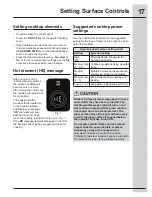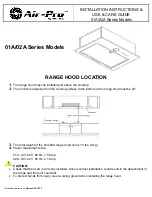
4
• User Servicing—Do not repair or replace
any part of the appliance unless specifi cally
recommended in the manuals.
All other
servicing should be done only by a qualifi ed
technician to reduce the risk of personal injury
and damage to the appliance.
• Never modify or alter the construction of
a range by removing leveling legs, panels,
wire covers, anti-tip brackets/screws, or any
other part of the product.
• Wear
Proper
Apparel—Loose-fi tting or
hanging garments should never be worn
while using the appliance.
Do not let clothing
or other fl ammable materials contact hot
surfaces.
• Storage in or on Appliance—Flammable
materials should not be stored in an oven,
near surface units or in the drawer (if
equipped).
This includes paper, plastic and
cloth items, such as cookbooks, plasticware
and towels, as well as fl ammable liquids. Do not
store explosives, such as aerosol cans, on or
near the appliance. Flammable materials may
explode and result in fi re or property damage.
• Do not leave children alone. Children should
not be left alone or unattended in the area
where an appliance is in use.
They should
never be allowed to sit or stand on any part of
the appliance.
• DO NOT TOUCH SURFACE UNITS, AREAS
NEAR THESE UNITS, OVEN HEATING
ELEMENTS OR INTERIOR SURFACES OF
THE OVENS OR WARMER DRAWER (if
equipped).
Both surface units and oven heating
elements may be hot even though they are
dark in color. Areas near surface units may
become hot enough to cause burns. During and
after use, do not touch, or let clothing or other
fl ammable materials touch these areas until
they have had suffi cient time to cool. Among
these areas are the cooktop, surfaces facing the
cooktop, the oven vent openings and surfaces
near these openings, oven door and window.
to cool. Among these areas are the cooktop,
surfaces facing the cooktop, the oven vent
openings and surfaces near these openings,
oven door and window.
• Never use your appliance for warming or
heating the room.
• In case of fi re or gas leak, be sure to turn off
the main gas shutoff valve.
• Do Not Use Water or Flour on Grease
Fires—Smother the fi re with a pan lid, or use
baking soda, a dry chemical or foam-type
extinguisher.
• When heating fat or grease, watch it closely.
Fat or grease may catch fi re if allowed to
become too hot.
• Use Only Dry Potholders—Moist or damp
potholders on hot surfaces may result in
burns from steam.
Do not let the potholders
touch hot heating surface units or interior oven
elements. Do not use a towel or other bulky
cloth instead of a potholder.
•
Do Not Heat Unopened Food Containers—
Build up of pressure may cause the
container to burst and result in injury.
•
Remove the oven door from any unused
appliance if it is to be stored or discarded.
•
Remove the oven door from any unused
appliance if it is to be stored or discarded.
• IMPORTANT—Do not attempt to operate the
oven during a power failure. If the power
fails, always turn the oven off.
If the oven
is not turned off and the power resumes, the
oven may begin to operate again. Food left
unattended could catch fi re or spoil.
Important Safety Instructions
Do not store items of interest to children in
the cabinets above the appliance.
Children
climbing on the range to reach items could be
seriously injured.
Electronic controllers can be damaged by cold
temperatures. When you use your appliance
for the fi rst time, or if it has not been used for a
long period of time, make sure that it has been
exposed to a temperature above 0°C/32°F for at
least 3 hours before connecting it to the power
supply.





































